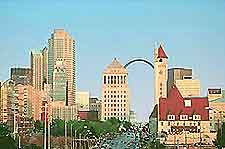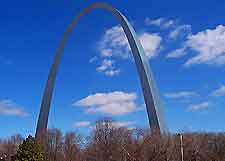St. Louis History Facts and Timeline
(St. Louis, Missouri - MO, USA)

Named after France's King Louis IX, St. Louis is one of those cities the French managed to keep hold of in the early days of history, before the inevitable US turn-over. It was also the last stop before pioneers would delve westward.
The city was set at the convergence of the Missouri and Mississippi rivers, and has been big in fur, steamboats and the auto industry, whilst also playing a part in the Civil War.
French Founding
The Native Americans built mounds in the St. Louis area, hence the nickname of 'Mound City', while Europeans - Frenchmen Louis Jolliet and Jacques Marquette, arrived via the Mississippi River Valley. The area was claimed by the French and a town was founded in 1764. A few years later, the Soulard Farmer's Market, which remains today on Lafayette Street, was set up.
St. Louis was governed by the Spanish up until 1800, although the Treaty of San Ildefonso saw it returned to France. This event is marked as Three Flags Day, with the lowering of the Spanish flag, the raising of the French flag and the subsequent raising of the US flag, after Napoleon sold Louisiana to Thomas Jefferson.
Steamboat St. Louis
By this time in history, St. Louis was the center of the American fur trade, being called home by around 1,000 people - Spanish, French and Native American. Explorers Lewis and Clark set off from St. Louis to chart the newly acquired Louisiana at this time. Accompanying the big fur trade were masses of steamboats, connecting the 'Gateway to the West'. Missouri author Mark Twain became a riverboat pilot around this time.

World's Fair and Olympics
St. Louis became a city in 1822 after Missouri was declared a state in 1820. An arsenal was built in 1827, although the city became divided in the Civil War, with slavery trials at the Old Courthouse adding fuel to the fire. The Old Courthouse remains on North Fourth Street and is part of the Jefferson National Expansion Memorial, one of the city's most historic structures. Union Station is also still standing, on Market Street, and hails from the 1890s. This Romanesque structure is best known for its fine mosaics.
The World's Fair was hosted in St. Louis in 1904 as the Louisiana Purchase Exposition, marking 100 years since the sale and Lewis and Clark's expedition. The city staged the Summer Olympics in the same year, with many of the finest places in the city built at this time. The fashion and auto industries were big business in the 1900s. Numerous original warehouses still stand in downtown and midtown today, as converted apartments and offices for local businesses.
Spirit of St. Louis
In 1908, the city hosted the first International Balloon Race, while in the year 1927, American aviator Charles Lindbergh crossed the Atlantic just a generation later in his Spirit of St. Louis. Many factories were set up for wartime use, while from the 1950s, urban renewal projects were begun, such as the Pruitt-Igoe housing project. Efforts to revitalize downtown were underway in the 1980s, and today the Washington Avenue Historic District contains several restored mansions, a number of which can be toured.
Through history, St. Louis went from primarily a manufacturing base to a center for research at the end of the 20th century, and there are now two major research universities located here. The city continues to develop its downtown core while retaining historic buildings.
 Named after France's King Louis IX, St. Louis is one of those cities the French managed to keep hold of in the early days of history, before the inevitable US turn-over. It was also the last stop before pioneers would delve westward.
Named after France's King Louis IX, St. Louis is one of those cities the French managed to keep hold of in the early days of history, before the inevitable US turn-over. It was also the last stop before pioneers would delve westward.